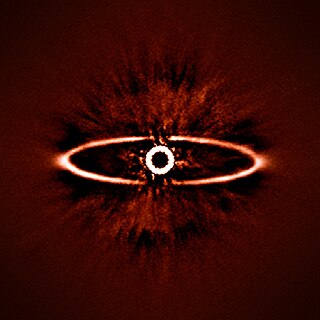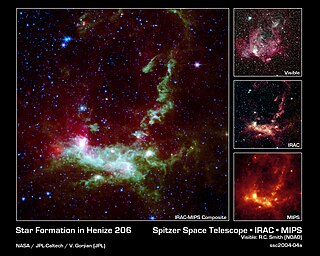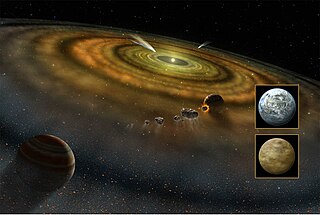
Epsilon Eridani, proper name Ran, is a star in the southern constellation of Eridanus. At a declination of −9.46°, it is visible from most of Earth's surface. Located at a distance 10.5 light-years from the Sun, it has an apparent magnitude of 3.73, making it the third-closest individual star visible to the naked eye.

The nebular hypothesis is the most widely accepted model in the field of cosmogony to explain the formation and evolution of the Solar System. It suggests the Solar System is formed from gas and dust orbiting the Sun which clumped up together to form the planets. The theory was developed by Immanuel Kant and published in his Universal Natural History and Theory of the Heavens (1755) and then modified in 1796 by Pierre Laplace. Originally applied to the Solar System, the process of planetary system formation is now thought to be at work throughout the universe. The widely accepted modern variant of the nebular theory is the solar nebular disk model (SNDM) or solar nebular model. It offered explanations for a variety of properties of the Solar System, including the nearly circular and coplanar orbits of the planets, and their motion in the same direction as the Sun's rotation. Some elements of the original nebular theory are echoed in modern theories of planetary formation, but most elements have been superseded.

A proplyd, short for ionized protoplanetary disk, is an externally illuminated photoevaporating protoplanetary disk around a young star. Nearly 180 proplyds have been discovered in the Orion Nebula. Images of proplyds in other star-forming regions are rare, while Orion is the only region with a large known sample due to its relative proximity to Earth.

The Spitzer Space Telescope, formerly the Space Infrared Telescope Facility (SIRTF), was an infrared space telescope launched in 2003. Operations ended on 30 January 2020. Spitzer was the third space telescope dedicated to infrared astronomy, following IRAS (1983) and ISO (1995–1998). It was the first spacecraft to use an Earth-trailing orbit, later used by the Kepler planet-finder.

BD+20°307 is a close binary star system approximately 300 light-years away in the constellation Aries. The system is surrounded by a dusty ring, and probably orbited by a 0.48M☉ white dwarf on a wide orbit.
HD 69830 is a yellow dwarf star located 41.0 light-years away in the constellation of Puppis. In 2005, the Spitzer Space Telescope discovered a narrow ring of warm debris orbiting the star. The debris ring contains substantially more dust than the Solar System's asteroid belt. In 2006, three extrasolar planets with minimum masses comparable to Neptune were confirmed in orbit around the star, located interior to the debris ring.

A debris disk, or debris disc, is a circumstellar disk of dust and debris in orbit around a star. Sometimes these disks contain prominent rings, as seen in the image of Fomalhaut on the right. Debris disks are found around stars with mature planetary systems, including at least one debris disk in orbit around an evolved neutron star. Debris disks can also be produced and maintained as the remnants of collisions between planetesimals, otherwise known as asteroids and comets.

HD 113766 is a binary star system located 424 light years from Earth in the direction of the constellation Centaurus. The star system is approximately 10 million years old and both stars are slightly more massive than the Sun. The two are separated by an angle of 1.3 arcseconds, which, at the distance of this system, corresponds to a projected separation of at least 170 AU.

HR 4796 is a binary star system in the southern constellation of Centaurus. Parallax measurements put it at a distance of 235 light-years from the Earth. The two components of this system have an angular separation of 7.7 arcseconds, which, at their estimated distance, is equivalent to a projected separation of about 560 Astronomical Units (AU), or 560 times the separation of the Earth from the Sun. The star and its ring resemble an eye, and it is sometimes known by the nickname "Sauron's Eye".

HD 37974 a variable B[e] hypergiant in the Large Magellanic Cloud. It is surrounded by an unexpected dust disk.

HR 8799 is a roughly 30 million-year-old main-sequence star located 133.3 light-years away from Earth in the constellation of Pegasus. It has roughly 1.5 times the Sun's mass and 4.9 times its luminosity. It is part of a system that also contains a debris disk and at least four massive planets. Those planets, along with Fomalhaut b, were the first exoplanets whose orbital motion was confirmed by direct imaging. The star is a Gamma Doradus variable: its luminosity changes because of non-radial pulsations of its surface. The star is also classified as a Lambda Boötis star, which means its surface layers are depleted in iron peak elements. It is the only known star which is simultaneously a Gamma Doradus variable, a Lambda Boötis type, and a Vega-like star.

WOH G64 is an unusual red supergiant (RSG) star in the Large Magellanic Cloud (LMC) satellite galaxy in the southern constellation of Dorado. It is one of the largest known stars, being described as possibly being the largest star known. It is also one of the most luminous and massive red supergiants, with a radius calculated to be around 1,540 times that of the Sun (R☉) and a luminosity around 282,000 times the solar luminosity (L☉).

A hypergiant (luminosity class 0 or Ia+) is a very rare type of star that has an extremely high luminosity, mass, size and mass loss because of its extreme stellar winds. The term hypergiant is defined as luminosity class 0 (zero) in the MKK system. However, this is rarely seen in literature or in published spectral classifications, except for specific well-defined groups such as the yellow hypergiants, RSG (red supergiants), or blue B(e) supergiants with emission spectra. More commonly, hypergiants are classed as Ia-0 or Ia+, but red supergiants are rarely assigned these spectral classifications. Astronomers are interested in these stars because they relate to understanding stellar evolution, especially star formation, stability, and their expected demise as supernovae.

Mensa is a constellation in the Southern Celestial Hemisphere near the south celestial pole, one of fourteen constellations drawn up in the 18th century by French astronomer Nicolas-Louis de Lacaille. Its name is Latin for table, though it originally commemorated Table Mountain and was known as "Mons Mensae". One of the eighty-eight constellations designated by the International Astronomical Union (IAU), it covers a keystone-shaped wedge of sky 153.5 square degrees in area. Other than the south polar constellation of Octans, it is the most southerly of constellations and is observable only south of the 5th parallel of the Northern Hemisphere.

Henize 206 is a nebula in the Large Magellanic Cloud. This luminous cloud of gas and dust houses a cluster of newborn stars. Although Henize 206 was first catalogued in the 1950s, it was reported in NASA press releases in March 2004, for showing several example images generated from the various infrared cameras on the Spitzer Space Telescope launched in August 2003.

An exoplanet is a planet located outside the Solar System. The first evidence of an exoplanet was noted as early as 1917, but was not recognized as such until 2016; no planet discovery has yet come from that evidence. What turned out to be the first detection of an exoplanet was published among a list of possible candidates in 1988, though not confirmed until 2003. The first confirmed detection came in 1992, with the discovery of terrestrial-mass planets orbiting the pulsar PSR B1257+12. The first confirmation of an exoplanet orbiting a main-sequence star was made in 1995, when a giant planet was found in a four-day orbit around the nearby star 51 Pegasi. Some exoplanets have been imaged directly by telescopes, but the vast majority have been detected through indirect methods, such as the transit method and the radial-velocity method. As of 1 March 2023, there are 5,332 confirmed exoplanets in 3,931 planetary systems, with 855 systems having more than one planet. This is a list of the most notable discoveries.

An exocomet, or extrasolar comet, is a comet outside the Solar System, which includes rogue comets and comets that orbit stars other than the Sun. The first exocomets were detected in 1987 around Beta Pictoris, a very young A-type main-sequence star. There are now a total of 27 stars around which exocomets have been observed or suspected.

HV 888, also known as WOH S140, is a red supergiant (RSG) star located in the Large Magellanic Cloud. It is among the largest known stars, with estimates of its radius ranging from 765 R☉ to over 1,700 R☉, and is also one of the most luminous of its type with a range of nearly 300,000 to over 500,000 times that of the Sun (L☉). The effective temperature is estimated to be around 3,500 K. If placed at the center of the Solar System, its photosphere would engulf the orbit of Jupiter and possibly even Saturn.
WOH G17 is a possible red supergiant (RSG) located in the Large Magellanic Cloud (LMC) or a Mira variable asymptotic giant branch (AGB) star in the constellation of Mensa. The star is often considered to be a foreground object; much closer than the LMC, probably in the Milky Way, and therefore is potentially much smaller and less luminous.


















